23214-92-8
| Name | doxorubicin |
|---|---|
| Synonyms |
ADM hydrochloride
Adriamycin hydrochloride (1S,3S)-3,5,12-trihydroxy-3-(hydroxyacetyl)-10-methoxy-6,11-dioxo-1,2,3,4,6,11-hexahydrotetracen-1-yl 3-amino-2,3,6-trideoxy-α-L-lyxo-hexopyranoside hydrochloride 5,12-naphthacenedione, 10-[(3-amino-2,3,6-trideoxy-α-L-lyxo-hexopyranosyl)oxy]-7,8,9,10-tetrahydro-6,8,11-trihydroxy-8-(hydroxyacetyl)-1-methoxy-, (8S,10S)-, hydrochloride Adriamycin (1S,3S)-3-Glycoloyl-3,5,12-trihydroxy-10-methoxy-6,11-dioxo-1,2,3,4,6,11-hexahydro-1-tetracenyl 3-amino-2,3,6-trideoxy-α-L-lyxo-hexopyranoside hydrochloride (1:1) [14C]-Doxorubicin [3H]-Doxorubicin 5,12-Naphthacenedione, 10-[(3-amino-2,3,6-trideoxy-α-L-lyxo-hexopyranosyl)oxy]-7,8,9,10-tetrahydro-6,8,11-trihydroxy-8-(2-hydroxyacetyl)-1-methoxy-, (8S,10S)-, hydrochloride (1:1) (1S,3S)-3-Glycoloyl-3,5,12-trihydroxy-10-methoxy-6,11-dioxo-1,2,3,4,6,11-hexahydrotetracen-1-yl 3-amino-2,3,6-trideoxy-α-L-lyxo-hexopyranoside hydrochloride (1:1) 5,12-naphthacenedione, 10-[(3-amino-2,3,6-trideoxy-a-L-lyxo-hexopyranosyl)oxy]-7,8,9,10-tetrahydro-6,8,11-trihydroxy-8-(2-hydroxyacetyl)-1-methoxy-, (8S,10S)-, hydrochloride (1:1) adriamycine EINECS 245-495-6 (1S,3S)-3,5,12-trihydroxy-3-(hydroxyacetyl)-10-methoxy-6,11-dioxo-1,2,3,4,6,11-hexahydrotetracen-1-yl 3-amino-2,3,6-trideoxy-a-L-lyxo-hexopyranoside hydrochloride (1:1) Doxil Adriamycin HCl DOXORUBICIN (8S-cis)-10-((3-Amino-2,3,6-trideoxy-α-L-lyxo-hexopyranosyl)oxy)-7,8,9,10-tetrahydro-6,8,11-trihydroxy-8-(hydroxyacetyl)-1-methoxynaphthacene-5,12-dione hydrochloride Rubex Adriamycin RDF (1S,3S)-3-glycoloyl-3,5,12-trihydroxy-10-methoxy-6,11-dioxo-1,2,3,4,6,11-hexahydrotetracen-1-yl 3-amino-2,3,6-trideoxy-a-L-lyxo-hexopyranoside hydrochloride (8S,10S)-10-((3-Amino-2,3,6-trideoxy-a-L-lyxo-hexopyranosyl)oxy)-7,8,9,10-tetrahydro-6,8,11-trihydroxy-8-(hydroxyacetyl)-1-methoxy-5,12-naphthacenedione hydrochloride Adriamycin, hydrochloride 5,12-Naphthacenedione, 10-((3-amino-2,3,6-trideoxy-α-l-lyxo-hexopyranosyl)oxy)-7,8,9,10-tetrahydro-6,8,11-trihydroxy-8-(hydroxyacetyl)-1-methoxy-, hydrochloride, (8S-cis)- Adriamycin PFS Adriblastin (8S,10S)-10-((3-Amino-2,3,6-trideoxy-α-L-lyxo-hexopyranosyl)oxy)-8-glycoloyl-7,8,9,10-tetrahydro-6,8,11-trihydroxy-1-methoxy-5,12-naphthacenedione hydrochloride (8S-cis)-10-[(3-Amino-2,3,6-trideoxy-a-L-lyxo-hexopyranosyl)oxy]-7,8,9,10-tetrahydro-6,8,11-trihydroxy-8-(hydroxyacetyl)-1-methoxy-5,12-naphthacenedione hydrochloride (8S,10S)-10-{[(2R,4S,5S,6S)-4-amino-5-hydroxy-6-methyltetrahydro-2H-pyran-2-yl]oxy}-6,8,11-trihydroxy-8-(hydroxyacetyl)-1-methoxy-7,8,9,10-tetrahydrotetracene-5,12-dione hydrochloride |
| Description | Doxorubicin is a cytotoxic anthracycline antibiotic for the treatment of multiple cancers. The possible mechanisms by which doxorubicin acts in the cancer cell are intercalation into DNA and disruption of topoisomerase-II-mediated DNA repair. |
|---|---|
| Related Catalog | |
| Target |
Topoisomerase II |
| In Vitro | Combination of Doxorubicin and Simvastatin in the highest tested concentrations (2 μM and 10 μM, respec-tively) kills 97% of the Hela cells[2]. |
| In Vivo | Mice bearing PC3 xenografts are injected with 2, 4 or 8 mg/kg Doxorubicin and tumor volume is measured over time. A dose of 2 mg/kg does not affect tumor growth while higher dosages delay tumor growth initially (p<0.05 at days 18 and 22), 4 mg/kg or 8 mg/kg Doxorubicin significantly reduces levels of c-FLIP in PC3 xenografts[3]. A single intraperitoneal injection 10 mg/kg (Doxorubicin 1) is administered in rats, 10 daily intraperitoneal injections of 1 mg/kg (Doxorubicin 2), or in 5 weekly intraperitoneal injections of 2 mg/kg (Doxorubicin 3). An 80% mortality rate is observed at day 28 in Doxorubicin 1, whereas Doxorubicin 2 and Doxorubicin 3 reached 80% mortality at days 107 and 98, respectively. Fractional shortening decreased by 30% at week 2 in Doxorubicin DOX1, 55% at week 13 in Doxorubicin 2, and 42% at week 13 in Doxorubicin 3[4]. |
| Cell Assay | 160 μL of Hela cells suspension (3×104 cell/mL) is dispensed into three 96-well U-bottom microplates and incubated for 24 h at 37°C in a fully humidified atmosphere of 5% CO2. In plate 1, serial dilutions of Doxorubicin (20 μL; final concentration, 0.1-2 μM) and Simvastatin (20 μL; final concentration, 0.25-2 μM) are added to a final volume of 200 μL and incubated for another 72 h. In plates 2 and 3 serial dilutions of each drug (Simvastatin or Doxorubicin, 40 μL) are added. After an incubation period of 24 h, the medium is aspirated and the cells are washed in PBS. Then, serial dilutions of other drug (40 μL) are added and supplemented with culture medium to a final volume of 200 μL, and incubated for 48 h. Doxorubicin and Simvastatin are used individually as positive controls (40 μL in each well), and the cells treated only with solvent are considered as negative controls. To evaluate cell survival, 20 μL of MTT solution (5 mg/mL in PBS) is added to each well and incubated for 3 h. Then the media is replaced with 150 μL of DMSO, and complete solubilization of formazan crystals is achieved by repeated pipetting of the solution. Absorbance is then determined at 540 nm by an ELISA plate reader. Each drug concentration is assayed in 4 or 8 wells and repeated 3 times. The cytotoxic/cytostatic effect of Doxorubicin is expressed as the relative viability (% control) and calculated. Percentage of cell survival in the negative control is assumed as 100. Relative viability=(experimental absorbance-background absorbance)/ (absorbance of untreated controls-background absorbance)×100 %[2]. |
| Animal Admin | Mice[3] Athymic male nude mice (3-4 weeks old) are used. PC3 cells (4×106) are injected subcutaneously into the flanks of mice. Animals bearing tumors are randomly assigned to treatment groups (five or six mice per group) and treatment initated when xenografts reached volumes of about 100 mm3. Tumors are measured using digital calipers and volume calculated using the formula: Volume=Width2×Length×0.52, where width represents the shorter dimension of the tumor. Treatments are administered as indicated using vehicle (PBS containing 0.1% BSA), Doxorubicin (2-8 mg/kg), Apo2L/TRAIL (500 μg/animal), or a combination of 4 mg/kg Doxorubicin followed by 500 μg Apo2L/TRAIL. Doxorubicin is administered systemically whereas Apo2L/TRAIL is given either intra-tumorally or systemically. All treatments are given once. Mice are monitored daily for signs of adverse effects (listlessness and scruffy apparance). Treatments seemed to be well tolerated. The mean±SEM is calculated for each data point. Differences between treatment groups are analyzed by the student t-test. Differences are considered significant when P<0.05. Rats[4] Thirty male Sprague-Dawley rats weighing 250 to 300 g are randomly assigned to 1 of 3 experimental groups: Doxorubicin schedule 1 (Doxorubicin 1, n=10), Doxorubicin schedule 2 (Doxorubicin 2, n=10), or Doxorubicin schedule 3 (Doxorubicin 3, n=10). For all Doxorubicin treatment schedules, the cumulative dose of Doxorubicin is 10 mg/kg. Schedule 1 involves a single bolus intraperitoneal injection of Doxorubicin at 10 mg/kg. Schedule 2 involves 10 intraperitoneal injections of Doxorubicin at 1 mg/kg for 10 consecutive days. Schedule 3 involves 5 intraperitoneal injections of Doxorubicin at 2 mg/kg, once each week, for 5 wk. Immediately before the first Doxorubicin treatment and at weekly intervals after beginning Doxorubicin treatment, blood pressure and cardiac function are assessed in all surviving animals as long as there are at least 3 rats per group. |
| References |
| Density | 1.61 g/cm3 |
|---|---|
| Melting Point | 205ºC |
| Molecular Formula | C27H29NO11 |
| Molecular Weight | 543.52 |
| Flash Point | 443.8ºC |
| PSA | 206.07000 |
| LogP | 1.50360 |
| Vapour Pressure | 9.64E-28mmHg at 25°C |
| Index of Refraction | 1.709 |
| Water Solubility | Soluble |
|
Material Safety Data Sheet
Section1. Identification of the substance Product Name: Adriamycin Synonyms: Section2. Hazards identification Harmful by inhalation, in contact with skin, and if swallowed. Section3. Composition/information on ingredients. Ingredient name:Adriamycin CAS number:23214-92-8 Section4. First aid measures Skin contact:Immediately wash skin with copious amounts of water for at least 15 minutes while removing contaminated clothing and shoes. If irritation persists, seek medical attention. Eye contact:Immediately wash skin with copious amounts of water for at least 15 minutes. Assure adequate flushing of the eyes by separating the eyelids with fingers. If irritation persists, seek medical attention. Inhalation:Remove to fresh air. In severe cases or if symptoms persist, seek medical attention. Ingestion:Wash out mouth with copious amounts of water for at least 15 minutes. Seek medical attention. Section5. Fire fighting measures In the event of a fire involving this material, alone or in combination with other materials, use dry powder or carbon dioxide extinguishers. Protective clothing and self-contained breathing apparatus should be worn. Section6. Accidental release measures Personal precautions: Wear suitable personal protective equipment which performs satisfactorily and meets local/state/national standards. Respiratory precaution:Wear approved mask/respirator Hand precaution:Wear suitable gloves/gauntlets Skin protection:Wear suitable protective clothing Eye protection:Wear suitable eye protection Methods for cleaning up: Mix with sand or similar inert absorbent material, sweep up and keep in a tightly closed container for disposal. See section 12. Environmental precautions: Do not allow material to enter drains or water courses. Section7. Handling and storage Handling:This product should be handled only by, or under the close supervision of, those properly qualified in the handling and use of potentially hazardous chemicals, who should take into account the fire, health and chemical hazard data given on this sheet. Store in closed vessels, refrigerated. Storage: Section8. Exposure Controls / Personal protection Engineering Controls: Use only in a chemical fume hood. Personal protective equipment: Wear laboratory clothing, chemical-resistant gloves and safety goggles. General hydiene measures: Wash thoroughly after handling. Wash contaminated clothing before reuse. Section9. Physical and chemical properties Appearance:Not specified Boiling point:No data No data Melting point: Flash point:No data Density:No data Molecular formula:C27H29NO11 Molecular weight:543.5 Section10. Stability and reactivity Conditions to avoid: Heat, flames and sparks. Materials to avoid: Oxidizing agents. Possible hazardous combustion products: Carbon monoxide, nitrogen oxides. Section11. Toxicological information No data. Section12. Ecological information No data. Section13. Disposal consideration Arrange disposal as special waste, by licensed disposal company, in consultation with local waste disposal authority, in accordance with national and regional regulations. Section14. Transportation information Non-harzardous for air and ground transportation. Section15. Regulatory information No chemicals in this material are subject to the reporting requirements of SARA Title III, Section 302, or have known CAS numbers that exceed the threshold reporting levels established by SARA Title III, Section 313. SECTION 16 - ADDITIONAL INFORMATION N/A |
| Hazard Codes | Xn |
|---|
| Precursor 7 | |
|---|---|
| DownStream 5 | |
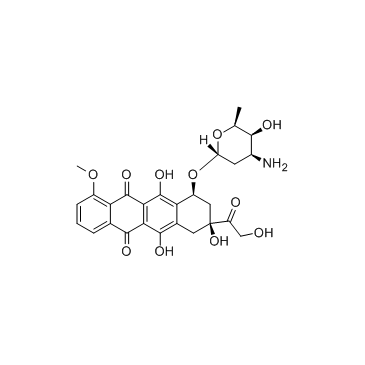
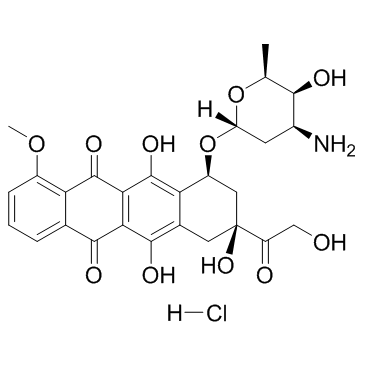
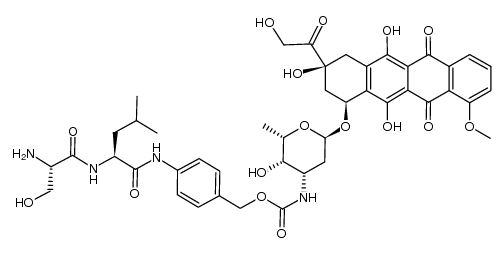
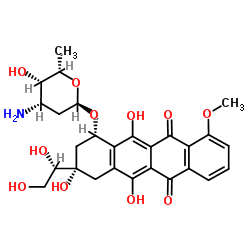
![N-[Nα-(9-fluorenylmethoxycarbonyl)valylprolyl]doxorubicine structure](https://image.chemsrc.com/caspic/072/791111-74-5.png)
![[ValPro]-[doxorubicin] structure](https://image.chemsrc.com/caspic/034/791111-75-6.png)
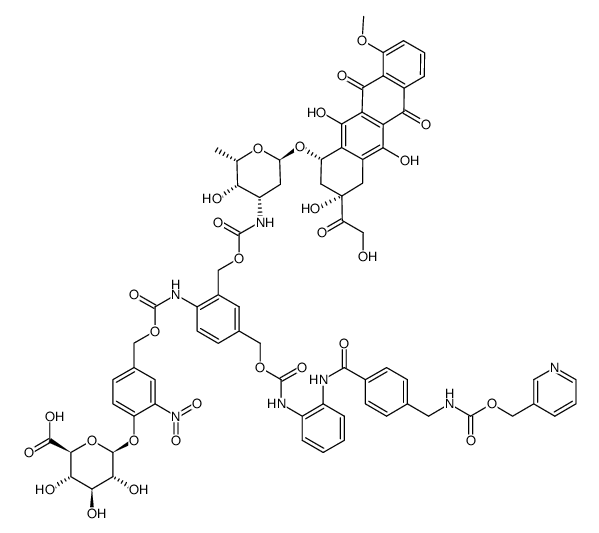

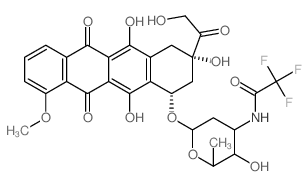
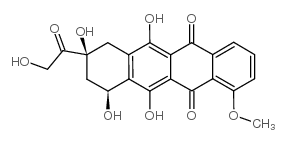

![5,12-Naphthacenedione, 7,8,9,10-tetrahydro-6,8, 11-trihydroxy-8- (hydroxyacetyl)-1-methoxy-10-[[2,3, 6-trideoxy-3-[(1-oxododecyl)amino]-.alpha.-L-lyxohexopyranosyl]oxy ]-, (8S-cis)- structure](https://image.chemsrc.com/caspic/286/76634-99-6.png)
![2,2,3,3,3-pentafluoro-N-[3-hydroxy-2-methyl-6-[[3,5,12-trihydroxy-3-(2-hydroxyacetyl)-10-methoxy-6,11-dioxo-2,4-dihydro-1H-tetracen-1-yl]oxy]oxan-4-yl]propanamide structure](https://image.chemsrc.com/caspic/453/80242-51-9.png)